Text

Shoot The Freak, Coney Island, NY 2008
36 notes
·
View notes
Text

Ship From Coney Island, NY 2008
Going to be posting some pre-lost harddrive images from before 2014 to keep the content going until my next trip in September. Mostly landscapes, barely any rock imagery, but it's all I got right now! Hope you enjoy!
48 notes
·
View notes
Text

AM Site, NM (iPhone photo from 2021)
Let’s get this out of the way first: The last time I posted this, a bunch of people called it modern, i.e., fake (it is not). It seems there are many who can’t wrap their head around the idea that not all rock imagery is representational to real-world experience. The Ancient Ones had as much (if not more) creativity and imagination as modern humans. They had intricate belief systems, unique ways of looking at the natural and spiritual world, and most of all, they didn’t always draw what they saw. When looking at rock imagery, we must try to separate our own way of thinking from that of a person from over 1,000 years ago. They just saw things differently. This could be a bear. This could be a creature from the artist’s cultural cosmology. It could be something made up on the spot. We will never know for sure. But I can assure you, this image is from the Mogollon culture, dating somewhere around 200-1450 CE.
The glyph itself is one of my absolute favorites of all the rock imagery I’ve seen over the years. The imposing, toothy head is the first thing that stands out, but then you start to notice the more subtle details of this design. The two “legs” have quartered circles for feet surrounded by dots. These “legs” look lighter, possibly added at a later date. The “crown” could be ears or horns. There’s what looks like a small tail and more dots running along the back. I can’t even begin to theorize what’s happening with the small front “arms” and the other design inside the body. I love the shape of the eye.
Interpretations are fun to make, as long as we understand that it’s all a guess, and the only one who truly knows what this image means is the person who created it. They would probably say it’s a T-Rex. 😂
102 notes
·
View notes
Photo

Colors & Textures, P Canyon, CA
73 notes
·
View notes
Photo



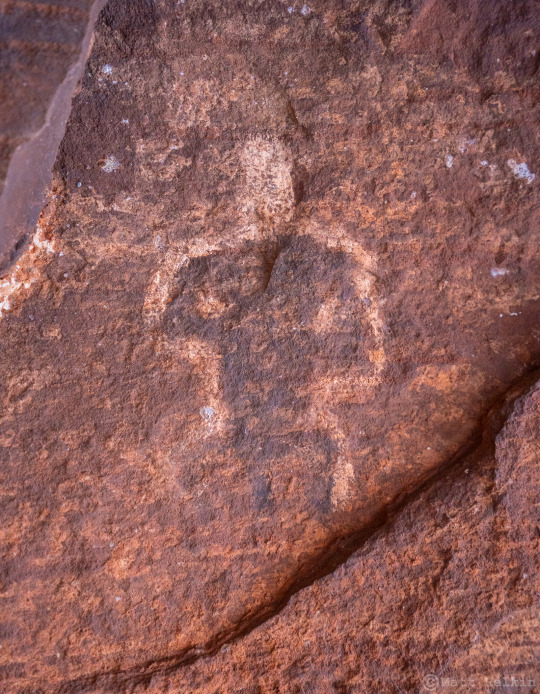
BC Site PART 3, UT. Final set of images from this Cave Valley Style site, showing what mostly look like anthropomorphs, with the exception of an antlered zoomorph in Slide 1. The figures with the zigzag heads and what can be described as “floppy ears” (Slides 1 & 2) exhibit a repeated design trait in this unique style. These are thought to be post-Basketmaker II (after 500 CE).
45 notes
·
View notes
Photo
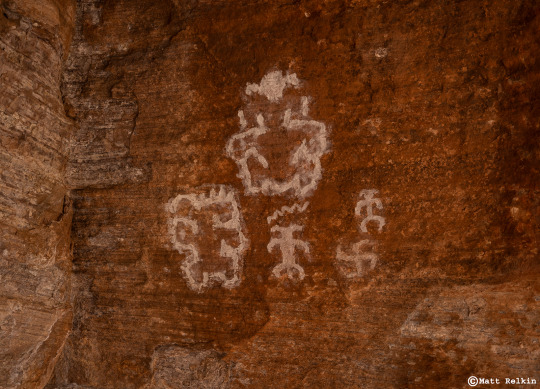
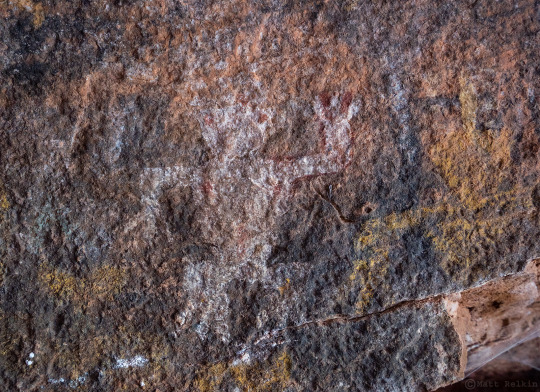

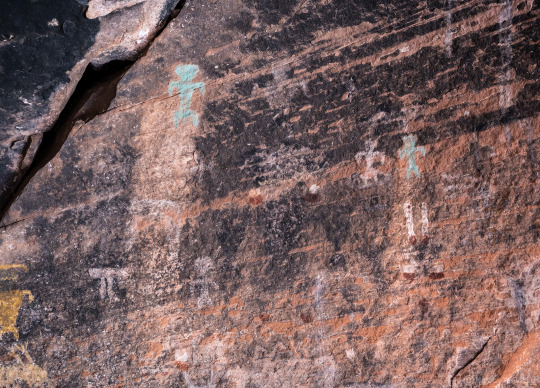
BC Site PART 2, UT. Some more Cave Valley Style glyphs from this excellent site. I especially like these reverse anthropomorphs in Slide 1. I’ve read this particular panel as being interpreted to depict childbirth, adding to the theory of this being a fertility site. This is also one of those rare locations that displays blue pictographs, possibly made from malachite or azurite.
78 notes
·
View notes
Photo



BC Site PART 1, UT. The Cave Valley Style has a few sites that are considered the litmus test for all others of this particular style. This site is one of those. Classic depictions of CVS triangular figures & zoomorphs adorn the interior walls of this alcove, thought by many to be a fertility site.
Slides 1 & 2 show an array of wide-hipped CVS figures, with the largest having a new set of legs and toes added at a later time. You can see the original leg stance sticking off the side of the hips, almost looking like saddle bags. The head of the main figure is adorned with rows of dots, another repeated motif found in many CVS anthropomorphs.
It needs to be mentioned that this site is now closed to the public, due to increased visitation that resulted in accelerated degredation. Publicly sharing locations on the internet is likely the primary cause for this uptick in foot traffic. These photos are from a past visit.
45 notes
·
View notes
Photo
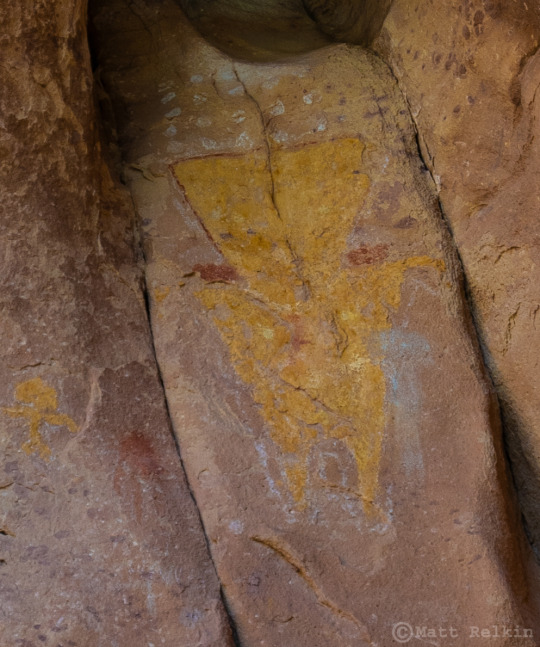
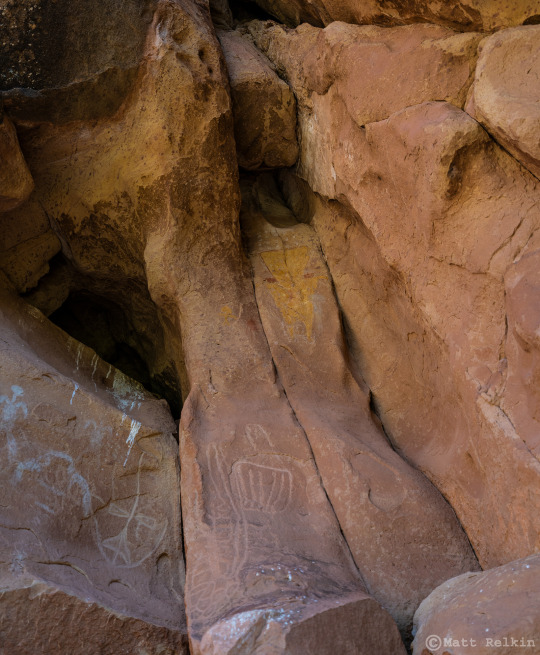


YM SIte, UT. Sticking with the Cave Valley Style, here’s another iconic glyph located in a high, shallow alcove. The central anthropomorph contains yellow (limonite or ocher), red (hematite or iron oxide), and what looks to me like blue (malachite or azurite) but is most likely white (gypsum or caliche). My editing may have given a blue tint to the white pigment. You can see the white (blue) around the outside of the body and in the dots above the head, which is another common characteristic of CVS anthropomorphs. The two red spots above the shoulders could be earrings or jewelry. Notice the small yellow figure to the left.
The rest of the site contains a mix of petroglyphs and graffiti, but there are some very old gyphs here. Slide 3 shows a beautiful concentric circle design and a figure that both exhibit full repatination, where the exposed rock surface has developed a new varnish that matches the rest of the rock surface. Slide 4 shows one of the only examples of Cave Valley Style figures in petroglyph form that I know of (the triangle forms towards lower center).
35 notes
·
View notes
Photo


RRA Site, UT. This site displays a textbook example of Cave Valley Style rock imagery. CVS is characterized by hyper-stylized anthropomorphs with triangular limbs and torsos, rarely having fingers and toes. The designs are consistently blocky and iconic, making them easily identifiable from the many other styles of rock imagery in the region. This unique style is centralized to a small region of Utah, with some overlap into northern Arizona. Researchers haven’t been able to pinpoint an exact timespan for Cave Valley Style rock imagery, though the consensus is this particular style came close to/after the Basketmaker II Period (around 1500 BCE-500 CE).
48 notes
·
View notes
Photo

Badlands Detail, Death Valley National Park, CA
203 notes
·
View notes
Photo

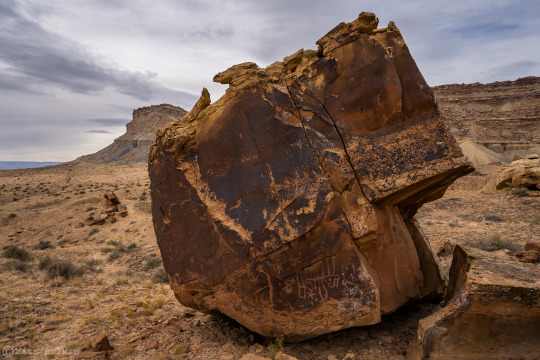
CC Site 4, UT. A very old panel that is likely from the Fremont Culture (around 1-1300 CE) or possibly older. There are other panels in this area that look like they could be Barrier Canyon Style, pushing those dates even further than 2,000 years. Notice the figure on the top left of Slide 1 is very similar in shape to the abstract* glyph directly to its right. The large glyph at the center could be a map of some kind, possibly geographic or astronomical. In Slide 2, if you zoom in, you can see a simple row of three sheep towards the center of the boulder. *I use the term “abstract” merely as a means to convey that I can’t personally come up with a representational explanation. I’m going to guess the person who created the “abstract” glyph had something specific in mind, be it observed or imagined.
122 notes
·
View notes
Photo
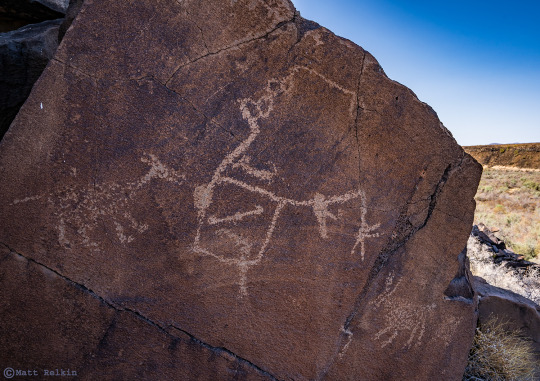
OP Site 7, AZ. Very intriguing design on this one.
27 notes
·
View notes
Photo

Off Hwy 89A, East of Navajo Bridge, AZ
370 notes
·
View notes
Photo

SP SIte 1, UT
31 notes
·
View notes
Photo

Zoomorphs, HP Site, AZ. A beautiful pair of zoomorphs that I’m betting are most likely sandhill cranes or blue herons. Both birds are known to have a long history in this area, especially sandhill cranes, which are one of the oldest living bird species in the world (Over 2 million years!). There is always the possibility of deeper meaning and symbolism in rock imagery, but I also believe some images could have been created for the sole purpose of immortalizing something the artist found to be beautiful. It’s hard to argue against that point with this particular panel.
39 notes
·
View notes
Photo

Endless Highway, Hastings Rd, UT
153 notes
·
View notes
Photo
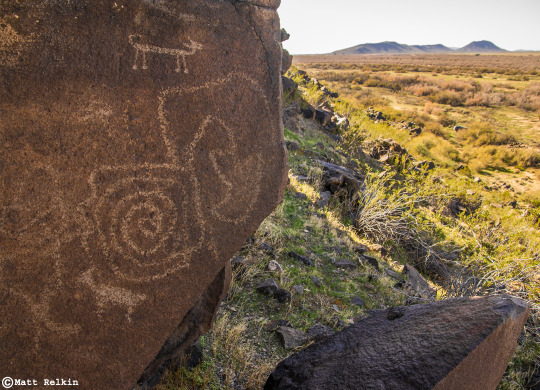
SP Site 6, AZ. Most of the glyphs at this site are credited to the Lowland Patayan people (around 1590-1900 CE), though there is some definite cultural overlap in this area.
82 notes
·
View notes